Religion of the Egyptians
By
Ottar Vendel
Worshipping
Clothing
Headgear
Regalia
Legends of Creation
The Myth of Osiris
Court in Underworld
Book of the Dead
Ka and Ba
Solar boat of Re
Burial customs
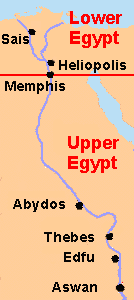 Ancient Egypt had by tradition a great variety of gods and what today can be labeled as spirits and divine forces. Some were depicted just as symbols and others had the form of living createures.
Ancient Egypt had by tradition a great variety of gods and what today can be labeled as spirits and divine forces. Some were depicted just as symbols and others had the form of living createures.In total they were over 2.000(!) but many had similar characteristics and appeared all over the country but with different names. This great diversity is due to the fact that before the country was united the northern Nile Valley was split up into about forty self ruling areas (later to be provinces - called nomes) where the ruling tribes had their own deities and leaders.
From the dualism of all gods it's clear that animals were the first to get divine status and by time got human form.
Because of this all gods had two things in common - they were family members with counterparts from the opposite sex and manifested them- selves on earth through animals.
Thus the local wild fauna of birds, crocodiles, snakes, turtles, frogs, plus cattle, dogs, cats and other domesticated animals were considered to be the living images of a particular god or goddess and a natural and indestructible part of the environment in which people lived.
All parts of life were covered and there were gods for - beer, plants, digestion, the high seas, female sexuality, gardens, partying etc. Many of them had lots of duties and were with time combined with each other in a great number of ways.
Some of them could appear in rather unusual forms like a goddess (curious even by Egyptian standards) having a head of a bee and body from a hippopotamus.
When having a glance at a depiction of them shown in upright position with human bodies, the goddesses are easy to single out since they always had their legs joined together, while the males used to be seen on the move - striding.
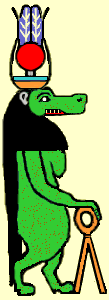 |
All aspect of daily life were covered by at least one of these deities, and like people on earth a vast majority of them were married (of- ten to their siblings) and had children.
Many ingredients made it possible for common people to identify themselves with them since their personalities were made of both divine strength and human weakness. They did most of the things that ordinary people did, like harvesting, hunting, eating, drinking, partying and even dying. Most of them were depicted as men and women combined with the head of the animal by which they were represented and they could appear in different costumes and be represented by several animals in the Egyptian fauna.
In other words - they could appear in many ways and yet some of them were so alike looking that it's impossible to identify them without reading the connecting text. Just looking at the dresses and the regalia they carry along isn't always enough, because they used to borrow objects from each other. This guesswork is a part of the charm when looking in to their in many ways, to us, unlikely world.
As to their names, today we use a blend of both their original Egyptian ones like Re, Ptah and Amon, and the Greek forms like Isis, Osiris and Horus.
As for the veneration of the gods scholars of Egyptology doesn't know exactly how this was made during the oldest times, or at what point in history the main gods had cult areas replaced by temples of their own.
One clue might be the god Min (see him) who obviously had a very old cult at Koptos in Upper Egypt where two statues of him larger then life size were found in the late 1800s. They had no doubt been situated within a sacred area or by a shrine of some sort, but no remains are left to reconstruct what it may have looked like.
After the formation of two separate countries along the Nile (Upper and Lower Egypt) a typical building came to be in each part, which more or less symbolized the country itself in both a religious and political way and underlined its national identity.
 |
It's most likely that local temples made of clay and reed originally were the cult buildings used by tribes along the Nile, and with time two shrines were specified where people could make offers to the main gods. Through their different designs it's easy locate the origin of old writings found since their depictions were incorporated into the hieroglyphic signs at an early stage (shown to the right of each illustration above).
Per-wer, meaning "the Great House", stood for Upper Egypt, and Per-nu, "the House of Flame" was the cupola shaped roofed national temple of Lower Egypt.
They are both attested for already during the reign of pharaoh Aha at the beginning of the first dynasty where they are present on a famous wooden label.
If at this stage, all mayor gods were worshipped in these buildings is not known.
With time the temples were elaborated to be great stone building just for a few very popular gods and goddesses which had fame over the centuries throughout the long Egyptian history. Minor gods had small shrines or were venerated in the homes.
When the goddesses and gods were depicted with a human body the variety wasn't so big in the way they were dressed. Less then half a dozen types of garments covers almost all of them. From the beginning they all wore white dresses, or at least single colored. This tradition slowly changed over the years and with time the colors and patterns became elaborated. The peak was reached during the Greco-Roman period when they were seen in outfits like actors in a costume spectacle in a theatre.
Excluding the mummy-like creations, here is a type description in brief:
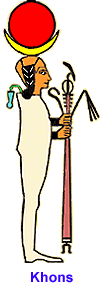 |
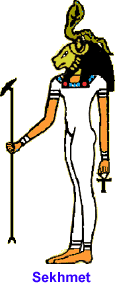 |
Notice that long sleeves were not in fashion in any era of Egyptian history, at least for the gods and goddesses. Their dresses were to a great extent similar to those worn by the upper classes in society during daytime and evenings, and mostly indoors.
The gods had a lot of different things to put on their heads, and they surely did. In bright contrast to the stereotyped positions of their bodies the painters and sculptors were keen on giving the heads as much attention as possible. This was obviously initiated by pharaoh himself or the priesthood in order to give their favorite gods as much promotion as possible. The different crowns could give a hint where the god originally came from, and by wearing the combined crown for the whole country, the message was given that this god or goddess was important to all Egyptians. To make them conspicuous all crowns, hats etc. were adorned with plumes, horns, snakes, flowers, sun discs, leaves etc painted in bright colors. Especially during the Greco-Roman era the fantasy and elaboration was significant.
 |
| Deshret Hedjet Peshent Peshent Atef Atef with horns Khepresh |
| EGYPTIAN CROWNS: The red one was from Lower and the white from Upper Egypt. The double crown represented the whole country. The |
Besides royal crowns the gods had a lot of other symbols and things to wear upon their heads. In some cases the headgear was necessary to identify the deities in ques-tion, when they were dressed the same, as they often were. Here is a selection of per-sonal things helping to identify which goddess is depicted in case the written hiero-glyphs don't give a clue. The following objects below are shown as they looked when the bearer in question was facing right.
Neit had the a stylised form of her shield and crossed arrows on her head. Isis wore a throne on top, a rather uncomfortable one it seems, and Maát had her standing ostrich feather she was named after. Nephtys had a building topped with a bowl-like object (for collecting rain water?) and Nut had a pot (or a broad vase) upon her head.
Selkhet wore the dangerous scorpion (without its deadly sting), and Seshat had the holy Persea-tree with two horns over it as her personal sign. Anat had a stylized cow's uterus as her token. Hathor had several objects in her hat box like cow's horns with the sun disc and her favorite musical instrument - the sistrum, which was a rattle.
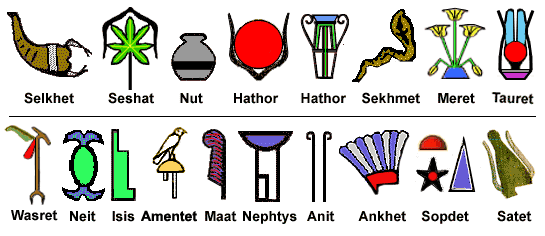
Especially the sun (symbolizing the god Re) was seen above the heads of many gods.
All paintings, drawings, sculptures and reliefs in Egypt followed a traditional scheme, and changes came slowly with time. Some artistic features did not alter anything at all, and remained unchanged for over 3.000 years. The way of depicting people are among these unaltered expressions of art. The body was normally in profile except for the torso which was shown from the front like the eye, to make the face more expressive. The gods (and kings) depicted were seldom empty handed - they usually carried various objects, and the symbolic meaning of some are still obscure to Egypto-logists. The gods usually had the well known
The other hand was holding a staff or scepter of some kind, and here we have half a dozen types. Goddesses usually had a scepter topped with a flower in different colors (like a white lily from the Nile) but this was seldom seen among the gods, possibly because it gave a more soft impression to the observer.
Very common through all times was the Was-scepter for "command" (see pictures below) and some gods, like Ptah and Osiris, had their own type of this staff.
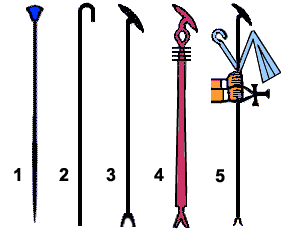 |
1) Sceptre with flower often carried by goddesses. 2) The herdsman's crook of god Anedjti, patron of shepherds and protector of domesticated animals. 3) Was-sceptre, stood for domination and power. It was very common among gods/kings in all times. 4) Staff of creator Ptah formed of four "djed-pillars" of order and stability (possibly a human spine). 5) Outfit of Osiris: crook and flail (cattle breeding and farming) plus the |
The Myth of Osiris
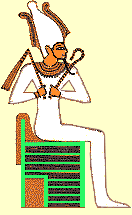 |
In the very beginning of time Osiris was king over Egypt and his queen (and sister) was the goddess Isis.
He was beloved by the people whom he told how to worship the gods and grow their crops for their daily bread. His brother Set became jealous and tried to overthrow him and become king himself. When participating in a feast with Osiris as host, Set began to describe a beautiful coffin he had, in a way that made the other guests curious.
 |
Everyone agreed that it was a magnificent piece of craftsman- ship and Set told them that he would give it away for free to whomever fitted exactly into it. Since he had made the coffin himself it was measured to fit one person only - his brother Osiris. When he placed himself in it everybody could see that he was the one who would get i as a present, but the evil Set had other plans. With his brother Osiris still in it, he and his fellows quickly nailed the lid and threw it into the Nile. Queen Isis was overcome by sorrow and began to search all over the land for it, but in vain.
One day she heard that a wonderful tree had sprung on the shores of Byblos in the north on the Eastern coast of the Mediterranean Sea, where the local king had cut it down and built a palace from it.
 |
During the night she managed to snatch it and embarked a boat heading for Egypt. When she came there she hid in the marshlands in the delta. There she opened the coffin and took a last farewell of her beloved husband Osiris and began searching for a suitable place to bury him. But Set was aware of all this and was hiding nearby. When Isis went to rest for the night he snatched the coffin and cut his brother's body into fourteen pieces and spread them all over Egypt. Isis became furious and asked her sister Nephthys and her son Anubis, to help her to find all the pieces of her husband's body.
 |
Isis made a wooden replacement for it and then put the whole body together. She now asked the sun god Re to make her husband alive just for one day, which he did, and they could have a last night of love together. The next day Osiris died and his body was embalmed by Anubis who thus made him the first mummy. Isis later gave birth to a son who was named Horus and she did all she could to keep it a secret from Set, but he found them and almost killed them in an ambush.
 |
When Isis came back she found her baby almost lifeless, and took him to the nearest village to get help. A wise old woman examined him and found out that it must have been Set as a snake who had bitten him. Thoth came to their rescue once more and drove out the poison from Horus' body and he recovered. He and his mother stayed hiding in the delta until he was a mature man and sometimes he took the form of a hawk and scouted out Set for the final showdown - the revenge on his murdered father. When that moment came they fought for three days until Thoth stopped the fight. They were both taken to the Court of Law in the Underworld and there they presented their versions of the story leading to the combat. The Court did not believe Set, who was sentenced to pull the boat with the sun across the sky forever. Horus now became the new king of Egypt like his father Osiris before him, and the good had finally conquered evil.
Isis put the body of her dead husband in a coffin and had nineteen identical coffins made in which she put duplicates. Priest from Egypt's twenty biggest towns then were given one each and could all thereafter claim that they had Osiris' tomb in their town. Thus many places in Egypt were (and still are) called Abusir - the place of Osiris.
Legends of creation
Ancient Egypt had different stories telling about how the world and all its inhabitants once came to be. The legends varied from province to province along the Nile, but after the unification a handful of them grew more popular and others were forgotten.
The priesthood in the cult centers of the creator-gods supported their own version and thus we meet gods like Atum, Re, Ptah, Khnum and Kheper performing the act as The Great Maker, but in different ways. There are no Deluge-legends involved in any of the creation stories of the Nile-people, probably because they had their own big flood every year and the beginning of everything couldn't possibly involve a banality like that.
The most common and probably one of the oldest stories, said that at the dawn of time there was nothing but the water called Nun, and the first ground coming out of it was a rock called the "Ben-Ben stone". From a slightly irregular shape at the begin- ning, with time it was elaborated and turned into a broad and short obelisk with a pointed top in a four-side pyramid fashion. Some scholars suggest that this might be the prototype for later pyramids tombs, but others do not.
On the Ben-Ben stone stood Atum and he coughed and spat out Shu and Tefnut.
PTAH from Heliopolis in Lower Egypt made the world by simply saying words and made earth raise from the water, very similar the story in the Bible.
RE (also from Heliopolis) is told in a rather late poetic legend to be the creator by using a tear from his eye to build all the world.
KHNUM from the island Elephantine at Aswan in the south, was the creator who made the world and all its people on his potter's wheel. The stuff was mud from the Nile.
KHEPER (representing Re) made all other gods from matter taken from his own body. He also created life (symbolically) every morning by commanding the sun to rise.
AMON from Thebes was during the New Kingdom vaguely connected to the creation of the World, saying that he once (like Atum) had created himself at the dawn of time.
THOTH was in Khemenu (Hermopolis) in Upper Egypt, the maker of the world and the first ones he helped to life were four frogs and four snakes, the so called Ogdoad.
The first family
The family from which all people in the world came was Shu, the god of cool air and his wife and sister Tefnut, goddess of rain, warm dew and moisture. They had the twins Geb who was god of the earth and Nut the goddess of the sky.
Before they had any children they were separated by command of the solar god Re and Geb wept over his loss and his tears made all the seas and oceans of the world.
One legend tells that Re for some reason (possibly jealousy) had become angry with Nut and laid a curse on her telling that none of her coming children could be born on any one day of the year. This was a big setback for Nut and Geb who were just planning to raise a family. In their agony they turned to the god of wisdom - Thoth, for advice. He went to his superior, the shadowy and not often depicted moon-god Aah who was in charge of the Egyptian moon-calendar. This old table of time consisted of 12 months of 30 days together making the moon-year of 360 days.
Thoth made Re a proposition to gamble about the matter and they started to play a game of dice resulting in victory for Thoth. He thereby won the moonlight of the five additional days of the true year (in this case July 14 to 18) and gave it to Geb and Nut who used them for the births of their children. Thus the curse of Re had no effect upon them because their children could all be born outside Aah's moon calendar. In the years to come Nut gave birth to five of the most prominent deities of Egypt: Year 1 - Osiris. Year 2 - Horus (the Elder). Year 3 - Set. Year 4 - Isis. Year 5 - Nephtys.
One of the oldest and best known legends comes from Heliopolis and goes like this:
From the beginning there was nothing but a water chaos called Nun, and from that came the god Atum, who had created himself. From matter taken from his own body, he made Shu, the god of the air and Tefnut, goddess of moisture and rain. They in turn had the twins Geb, the earth-god, and Nut, the goddess of the sky.
From these two (Geb and Nut) then came all other Egyptian gods and goddessses.
Shu was often seen holding up the sky (his daugter Nut) with his son Geb lying under- neath (picture below). This family of four was the very foundation upon which the world existed as they represented the basic elements: earth, water, air and sky.
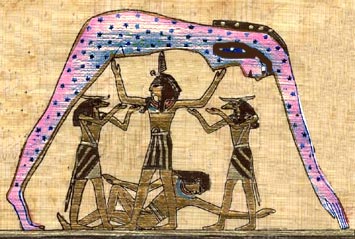 |
1) The old tradition from Heliopolis (Iunu) just north of Memphis in Lower Egypt said the creation of all the gods was made by Kheper, who was another form of their local sun god Re.
He was self-produced and made the other gods out of the matter of his own body. He was the father of many gods like Osiris, Nephtys, Isis, Set, Horus and others.
2) The priests from Hermo- polis in Upper Egypt declared for their part that Thoth was the primeval god and created the first four couples that built up everything. The first pair was Nun and Nuntet (snakes), who represented and dwelled in the mass of water from which everything emerged. The second was Heh and Hauhet (frogs), who stood for indefinite time and long life. The third was Kek and Keket (snakes), who embodied darkness, and the fourth pair was Niau and Niaut (frogs) representing the void. During the New Kingdom the two latter were replaced by Amon and Amonet.
3) In Sais (in the delta in Lower Egypt) the priests taught the people that their own mighty godd- ess Neit was behind the origin of the other gods. She was
4) Another story tells that the creation of The World was wet and dark and Atum-Re arose from the Nun and appointed the eight reptile gods above (the so called Ogdoad) to their proper places and brought order from chaos. Here the frogs Niau and Niaut have been changed for Amon and Amonet which tells that this version is of later date (New Kingdom) when Amon had reached a lofty position among the gods.
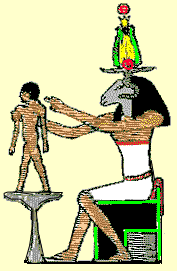 A very old legend in Egypt told that mankind was divided into four types when they were made on the potter's
wheel by the great creator Khnum. He made them all out of mud of various colors from the Nile.
A very old legend in Egypt told that mankind was divided into four types when they were made on the potter's
wheel by the great creator Khnum. He made them all out of mud of various colors from the Nile. The order in which they were made was as follows: First was - Romut, meaning "men", and these were the Egyptians them- selves. The second to come from the potter's wheel was - Áamu, the people from the desert mountains east of the Nile. This name was later also used for Asians in general.
Number three, called - Temehu, was the fair skinned people from the Mediterranean coast west of the Nile Delta and the oases west of the Nile Valley.
The last to be made was - Nehesy, the black people to the south of Egypt, below the province of Nubia.
Notable is that the names of these people seem to be very old and originating from the early times when the Egyptians didn't have a name for Asians, which they surely encountered well before the first dynasty as shown in archaeology remains.
According to another (much younger) legend mankind was created from a tear that fell from the eye of the god Re, and turned into men and women. The fair-skinned Libyans, considered as "cousins" by the people in the Nile valley, were formed in the same way. The two other people have a tear from Re as their origin too, but in a more irregular way.
When a person had died he was taken to Underworld where his deeds in life were taken to the Court of Osiris for the final judgement. Since this place also was called "The Island of Fire" it's quite obvious that the Egyptians had knowledge about the burning interior of the Earth though they had no volcanoes in their own country. Before coming there the dead person had to pass a labyrinth of gates and doors and answer questions correctly to pass through. The lion-god Aker let him through the last gate and he was facing the fourteen members of the jury in the Tribunal Hall. There he was allowed to speak about his behavior on Earth. (Shown in the upper left in the picture below).
Then god Anubis took him into the courtroom presenting him the scale where his heart would be put in balance with the feather of the goddess Máat, patroness of truth and harmony. The procedure was recorded by Thoth - the god of writing and wisdom. Sometimes Thot's animal (a baboon) was sitting on top of the scale ready to adjust the result using a sliding weight.
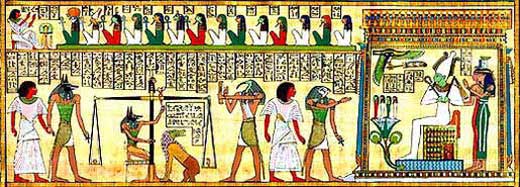
|
The deceased enters from the left guided by Anubis. His heart is placed on the scales and the result is recorded by Thoth. Then Horus takes him in front of the judge Osiris for the final verdict. Behind the throne stand Isis and Nephtys.
|
If the heart of the deceased wasn't too heavy with sins from his life on Earth, he went through and could continue his voyage to the afterlife and was granted a plot of land in the "Field of the Reeds". This was the paradise for the ancient Egyptians - to grow crops for eternity in a land that was the very image of the Nile Valley they just had left.
If he failed the test on the other hand - his heart was immediately devoured by the beast Ammut sitting under the scale ready to have a good blow-out. In that case the dead faced the most horrible future imaginable for the Egyptians - he was denied an eternal life in the land in the West and his soul would be restless forever.
|
1. Crossing the celestial river by Nemty to the "Land in the West". 2. Passing through gates and labyrinths by answering questions. 3. Being let into the great Court of the Underworld by the god Aker. 4. Addressing a jury of 14 judges about the deeds during life on Earth. 5. Taken by Anubis to "Balance of Truth" to weigh his heart for sins. 6. If the heart wasn't heavy, brought by Horus to Chief Judge Osiris. 7. Entering the "Fields of the Reed" (Paradise) and get eternal life. |
The Book of the Dead
The Book of the Dead was (in most versions) an illustrated manuscript which consisted of prayers and magical texts to be used during the funeral and read over the dead to ensure the survival in the afterlife.
These texts were a necessary part of the funerary equipment and were thought to help through dangers of the Underworld. Over 150 burial spells were written on papyrus and placed with the dead and the content has been traced back to the Old Kingdom Pyramid Texts from 2.300 BC and had probably a long oral tradition before that.
Each nome (province) and even towns had their own version putting text mentioning the local gods in favor.
For poor people (the average Egyptian man and woman) there were versions not so elaborated (and expensive) and just containing the essence. A big part concerned the moment when the dead came in front of the jury in the Underworld. There he would make confessions like: "I have not killed or used false weights on my balance, or caused pain to anyone". Then he usually stated things like: "I have given clothes to the naked, water to the thirsty and bread to the hungry" etc, all to convince the jury members of his kind-heartedness.
One spell was spoken in front of a tribunal of 42 gods, and proclaimed innocence of a series of specified sins that covered every kinds of wrong doing. This made the soul worthy to go further into the Judgement Hall where the Court of Osiris (see above) had the final word. Being approved of there he was ready to embark on the Boat of Re to sail to the "Land in the West" for eternal rest.
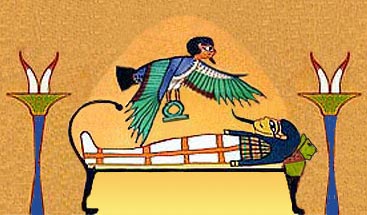 |
The human soul - Ba, seen as a bird, hovering over his newly mummified master on his bier. |
The purpose of preserving the body through embalming is clearly shown in the two components the Egyptians thought built up a man's personality. In both cases the physical body was essential for their existence and an eternal life for the deceased.
The Egyptians believed that every person (during life and after) was followed by an invisible double called - Ka. He was created at the moment of birth and stood for "force of live" for the person. He could not be seen or depicted but all big tombs had a "blind door" for him to use. After death a transformation of rebirth took place and every night he was released to give his dead master a spiritual travel to the land of the living. The travel itself was made by his soul Ba (see beyond). This was a link from the tomb to life on earth that was supposed to go on forever.
The poor commoners who couldn't afford an embalming were offered small simple statuettes of mummies to give their Ka someone to stand beside in the life beyond and thereby please their life-long companion and get eternal rest themselves.
 |
Ka (left) walking beside the body and Ba who was dwelling within. |
 |
The human soul was called - Ba and was depicted as a bird with a human face, sometimes with the features of the dead person. The Ba (like Ka) appeared for the first time at the moment of birth, but the Ba was dwelling within the body, and after death in the mummy. During life he was his master's conscience and after death he was himself protected from being misled by evil spirits through rituals and prayers from "The Book of the Dead" performed by priests or relatives. A correct behavior in both worlds was essential to the Egyptians.
After death he was released from the mummy every night and could fly back to the world of the living to check things out. Before sunrise he was back within his master, who thus never lost contact with the world he had left.
The story of the sun god Re and the voyage in his boat was one of the most important in Egyptian mythology and concerned the very basics of life for the people in the Nile Valley. It clearly shows the cyclic way of looking at time and life that was at hand since the oldest times for Egyptians.
The religious beliefs in Heliopolis in Lower Egypt told that Re was the creator of men and at the beginning of the fifth dynasty he reached a very lofty position when the kings adopted his name in their titles claiming to be his sons.
Re traveled through the waters of heaven in two different boats each day. The first, Madjet ("being strong"), rose out of the east behind the Mount Bakhu and then passed between two sycamore trees. At noon he was transferred over to a small bark by the name of Semektet ("going weak"), and this vessel took him into the sunset in the west at Mount Manu.
He did not navigate the boats himself because this was taken care of by Máat, goddess of justice and stability. She was first mate on the bridge and set the course accompanied by Horus.
The life-giving Re (the sun disk) and the symbol of creation the beetle Kheper on the very first day. Onboard are the gods who had helped to formed the World. The boat was held up by Nun, the lord of the watery chaos be- low from which everything had emerged at the dawn of time - the day before. (See also the gods Hu and Sia). | 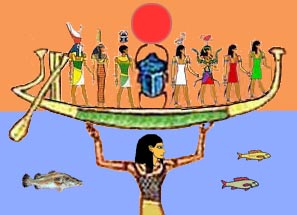 |
The boat was not provided with sails, but had another way to get power to move. It was simply pulled across the sky by the evil god Set who had been condemned to do so for killing his brother Osiris (as told in the Myth of Osiris above).
At night the god Upuaut stood on the prow and navigation was assisted by pilot fish Abtu and Ant, who swam in front of the boat.
The crew consisted of the gods Geb and Heka plus the companions Hu and Sia. They all helped Re to overcome the obstacles set up by those who tried to stop his journey - the three monsters Sebau, Nak, and Apep. The evil creature Apep was the most dangerous one and he took the shape of a big snake or a crocodile.
Under the protection of war god Maahes, Re fought and killed the monsters every day and thus secured the way for the sun to rise the next morning. By then the participants were all alive and kicking again and the daily combat could begin as usual.
Cloudy days were scary to the Egyptians because it might be that Apep had stopped Re in his boat. To prevent this and make things go back to normal again they made extra offerings in the temples to make the sun come back.
By begging Re to come back in the morning the Egyptians hoped that daily life should go on as usual. Since agriculture was the base of the country, the life giving sun was essen- tial for people's well being and existents. Scene from a prayer book. | 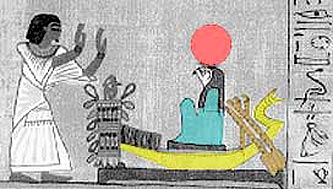 |
The most critical days, that thankfully did not come often, were those with solar eclipses in different stages. It seemed that Apep was swallowing up the sun, but somehow, after extra ceremonies, Re turned out to be the winner in the end. There were even manuals for people to help to fight this evil snake/crocodile that could jump up from the heavenly waters and attack the boat and the people onboard. Even the otherwise bad god Set took part in the struggle, besides pulling the boat, which underlines the importance of the mission.
The essence of this myth is that the sun (symbolizing life itself) was a constant struggle. A lifetime for a man was a similar voyage with the birth and peak of living at noon. At twilight life was coming to an end and people finally reach the glorious Land In the West - the next World, after their short stay on Earth.
By venerating the gods who struggled every day to make the life-giving sun keep shining, order and stability was secured. This was what the chief navigator goddess Máat stood for and she always managed to get the old barge to port.
The basic purpose of mortuary preparation was to ensure the deceased a successful passage into the next world. The tombs were from the very beginning shallow holes in the sand later to be lined with a wall of sun dried bricks or stones and topped by a mound of sand or clay. The substructures were elaborated downwards when pits leading to grave chambers were cut out in the bedrock starting around 3200 BC. The structures above ground developed into bench-like brick buildings (mastabas) later to be made of stone and ending with the great pyramids 2.400 BC, a time span of evo- lution for almost half a millennium.
The amount of grave goods and offerings (for wealthy people) was increasing and be- came more sophisticated and progress was also seen in the treatment of the body of the deceased - the mummification. This custom first appeared also in about 3200 BC. and steadily progressed technically for the next 2.000 years from simple dehydration (made by the dry climate) to prepa- rations with chemicals.
Originally the dead was placed in a crunched position lying on the side, but with time traditions changed and they were stretched out on their backs.
The religious belief was that the body should be preserved intact for the soul to dwell within in the next world. This made kings and other royalties hide their dead protected under mountains of stone (pyramids) and later in secret hideouts in the desert cliffs. Unfortunately the huge monuments draw attension from poor people, and Egyptians never separated the valuable offerings and grave goods from the mummies, which made the robbers plunder it all during periods of political instability.
During the long periods prosperaty, which could last for hundred of years, cults of long deceased kings is noted to have been going on for many generations. In these the content in "the Book of the Dead" (see above) was a crucial element.
Anubis who was the watcher over the cemeteries, also took care of the important mummification. In the picture he is making an em-balming to make the dead keep his looks in the next world. Without a physical body the soul had no place to dwell and would be restless forever. Poor people could only afford small clay figurines as substitute for a mummified body. |
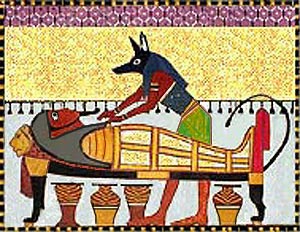 |
Thus the great kings from the Old Kingdom did not come to "the Field of Reeds" after death despite (or more accurate: just because) they tried to protect themselves under mountains of stone, which draw attention to everybody, not the least tomb robbers.
The next world was located in more than one place both in a physical and a religious (metaphysical) sense. It could be 1) in the area around the tomb, 2) among the stars, 3) in the celestial regions with the sun god or 4) in the Underworld itself.
All places had one thing in common: they were all located in "The Beautiful West" where the day (and life) ended with the setting sun.
The journey to the next world was fraught with obstacles in the Underworld. It was a trip by boat through many gates with tricky questions to answer. The judgement after death (see "the Book of the Dead" above) was a subject often depicted from the New Kingdom and onwards. The belief itself was much older, probably from before the first dynasty 2000 years earlier. It was the final judgement whether the deceased had been a good human being or not. Most of them (with means) could pass by giving offerings to the gods and making declarations about their good behavior on Earth, true or not.
Egyptian History and its famous Kings